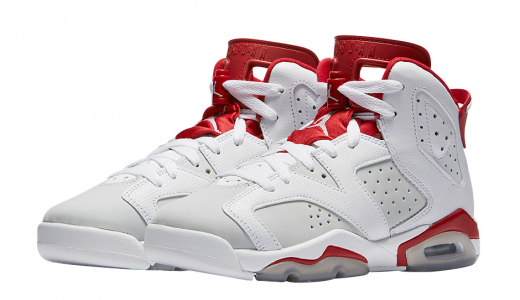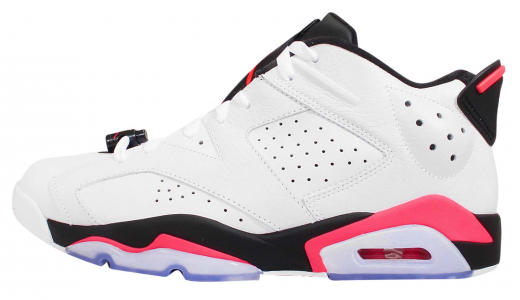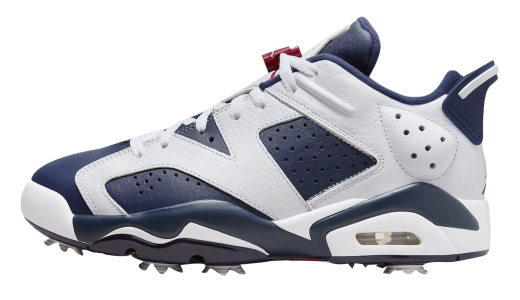Air Jordan 6
The Air Jordan 6 is a revered sneaker that occupies a distinguished place in the annals of sneaker history and Michael Jordan's legendary career. Designed by Tinker Hatfield and released in 1991, this model marks a pivotal moment as the shoe Michael Jordan wore when he clinched his first NBA championship with the Chicago Bulls. The Air Jordan 6 is celebrated for its combination of performance and aesthetics, featuring a unique silhouette characterized by its clean lines, perforated panels, and supportive ankle padding. The sneaker includes design elements like the iconic rubber tongue with two grip holes, lace locks, and a translucent outsole which not only gave it a futuristic look but also provided the necessary traction and stability needed on the court. The heel tab, said to be inspired by the rear spoiler of Jordan's sports car, added a touch of speed and performance, underscoring the sneaker's blend of athletic utility and stylish appeal.
Beyond its technical specifications, the cultural impact of the Air Jordan 6 extends far beyond basketball courts. It has become a staple in the world of streetwear and fashion, embraced by sneaker enthusiasts, collectors, and celebrities alike. The original colorways, such as the "Infrared" and "Carmine," have been re-released multiple times, each iteration met with immense anticipation and enthusiasm. The Air Jordan 6's enduring popularity can also be attributed to its appearances in popular culture, ranging from music videos to movies, further cementing its status as an iconic piece of footwear. Decades after its initial release, the Air Jordan 6 remains a testament to the seamless fusion of sport, design, and culture, continually inspiring new generations while preserving its legacy within the Jordan brand lineage.
History of Air Jordan 6
The story of the Air Jordan 6, a pivotal model in the extensive history of the Air Jordan line, is a tale of innovation, triumph, and cultural significance. The Air Jordan series, associated with NBA legend Michael Jordan, transformed the landscape of sports footwear and fashion. By the time the Air Jordan 6 was introduced in 1991, the brand had already established itself as an icon, but this model namely took it to another level, underlining moments of both athletic greatness and design evolution.
Context and Design Development:
In the late 1980s and early 1990s, Michael Jordan was on a meteoric rise. By that time, he had already secured his place as a powerhouse in the NBA. Nike, recognizing his unparalleled marketability, consistently aimed to innovate with each successive model in the Air Jordan line. The Air Jordan 6 was the product of this ongoing drive for excellence.
Tinker Hatfield, a legendary designer at Nike, was once again at the helm for this model. Hatfield had been behind the design of Air Jordans since the Air Jordan 3 and had a keen sense for blending performance with aesthetic appeal. With the Air Jordan 6, Hatfield sought to address both practical demands from Michael Jordan himself and the evolving tastes of sneaker enthusiasts.
Design Features:
Several design aspects distinguished the Air Jordan 6 from its predecessors and contributed to its historical significance:
1. **Visible Air-Sole Unit:** Like previous models, the AJ6 featured a visible Air-Sole unit in the heel for cushioning, but this was further refined.
2. **Support Structure:** Michael Jordan had expressed the need for improved support and structure. Hatfield responded by incorporating two holes in the tongue for better grip when putting on the shoe, and they included a molded heel tab to enhance ease of wear.
3. **Inspiration from Sports Cars:** Hatfield drew inspiration from Jordan’s love for sports cars. This influence was evident in the angular design patterns and the streamlined silhouette of the shoe, reminiscent of a car’s sleek lines.
4. **Toe and Heel Reinforcement:** The design improved toe and heel protection areas, catering to Michael Jordan’s demands for performance on the court. The reinforced toe box and additional heel tab provided both aesthetic appeal and functionality.
5. **Translucent Outsole:** The Air Jordan 6 was one of the early models to incorporate a partially translucent outsole, giving it a futuristic look and providing better traction on the court.
6. **Lock Lacing System:** To ensure a perfect fit and reduce slippage, Hatfield introduced the new lock lacing system. This was particularly innovative and a feature that would become prominent in later models.
Performance Legacy:
The Air Jordan 6’s performance was as groundbreaking as its design. Michael Jordan wore the AJ6 throughout the 1990-1991 NBA season, during which he achieved numerous milestones. Two of the most significant feats were:
1. **First NBA Championship:** Wearing the Air Jordan 6 “Infrared” colorway, Michael Jordan led the Chicago Bulls to their first-ever NBA Championship in 1991, triumphing over the Los Angeles Lakers in a five-game series. This victory cemented Jordan’s status as the NBA's greatest player at the time and brought a heightened level of prestige to the Air Jordan brand.
2. **Finals MVP Award:** Jordan’s exceptional performance in the finals earned him his first NBA Finals MVP award. The image of him crying and holding the championship trophy while wearing the AJ6 has become an iconic moment in sports history.
The shoes effectively performed on the court, providing unparalleled support and cushioning, helping Jordan to perform at his peak, and achieving what many considered an unachievable harmony between function and form.
Cultural Impact:
Beyond the court, the Air Jordan 6 resonated deeply within sneaker culture and broader pop culture. Here are a few ways the AJ6 left an indelible mark:
1. **Fashion Statement:** Sneaker enthusiasts and fashion aficionados quickly embraced the Air Jordan 6. The sleek design, distinctive features, and association with Michael Jordan’s success made it a sought-after commodity.
2. **Television and Movies:** The AJ6 made notable appearances in popular media. For instance, fresh-faced actor Will Smith famously wore the “Infrared” Air Jordan 6 in the hit television show "The Fresh Prince of Bel-Air," enhancing the sneaker's cultural cachet.
3. **Hip-Hop Culture:** The emergence of hip-hop in the early '90s saw the genre embracing the Air Jordan brand. The Air Jordan 6’s visibility in music videos and on the feet of popular artists added to its allure.
4. **Legacy in Sneaker Collecting:** As sneaker collecting became a more ingrained subculture, the significance of the Air Jordan 6 grew. Original colorways from the initial release and limited editions became highly coveted items.
Subsequent Releases and Retro Revivals:
The enduring appeal of the Air Jordan 6 prompted Nike to re-release the model several times, known within the community as “retro” releases. Each new iteration paid homage to the original while sometimes introducing new materials or colorways to keep the design fresh for new generations of fans.
1. **Mid-2000s Resurgence:** The mid-2000s saw a renewed interest in the Air Jordan 6, with successful retro releases that included the “Defining Moments Package” which contained both the Air Jordan 6 and the Air Jordan 11, commemorating Jordan’s first championship.
2. **Anniversary Editions and Collaborations:** Nike capitalized on anniversaries of Jordan milestones by releasing special editions. Collaborations with notable designers and brands further propelled the Air Jordan 6's status in the world of high fashion and streetwear.
3. **Coveted Colorways:** Colorways such as “Infrared,” “Carmine,” and “Olympic” became particularly iconic. The “Infrared” and “Carmine” patterns, in particular, held deep roots in the shoe’s initial legacy and were beloved by purists.
4. **Performance Line Revival:** Beyond retro releases, the Jordan brand also occasionally updated the model with advanced technology to maintain its relevance for athletic use.
Icon Status:
The Air Jordan 6 has undoubtedly attained icon status within the sneaker world. The shoe's historical significance is multi-layered: it is remembered not only for its innovative design and technological advancements but also as a symbol of Michael Jordan's first taste of ultimate victory in the NBA. This combination of athletic triumph and cultural zeitgeist continues to resonate.
This iconography extends to modern times, as the Air Jordan 6 is often referenced or recreated in limited editions that sell out almost immediately, emphasizing the model's lasting influence. Collectors often seek out original pairs from 1991, purely for their historical value and unique place in sneaker history.
Conclusion:
With its introduction in 1991, the Air Jordan 6 was a game-changer, playing a crucial role in cementing Michael Jordan’s legacy and setting new standards in sneaker design and performance. The model was symbolic of Jordan’s first NBA Championship, showcasing a blend of functional innovation and aesthetic excellence. Under the creative genius of Tinker Hatfield, the Air Jordan 6 featured groundbreaking elements that would influence sneaker design for decades to come.
The cultural proliferation of the Air Jordan 6 saw it transcend the boundaries of sport, seeping into the realms of fashion, media, and music. Its enduring legacy is maintained through retro releases, special anniversary editions, and coveted collaborations, ensuring that the Air Jordan 6 continues to captivate new audiences while honoring its rich history. Indeed, the Air Jordan 6 remains a timeless icon—a testament to the past, a staple of the present, and an inspiration for the future in the world of sneakers.























